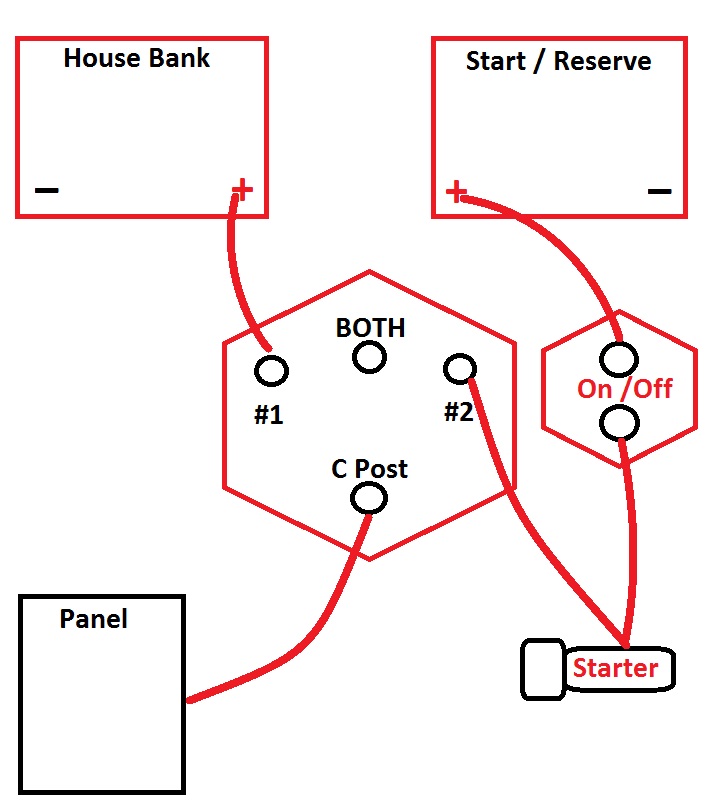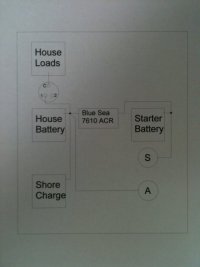Of course, please do !
-Sven
When I bought the boat, it had two Group 27 hybrid starter/"deep cycle" wet cell batteries from Costco. They were connected to the starter and the house through a Perko 1,2,all,off switch. They were also connected to a 50-watt solar panel (and a solar charger with a lousy float profile), the stock alternator, and an AC charger. The two batteries were isolated/combined by a BlueSea Systems Automatic Charging Relay.
The solar charger and it's bad profile kept overcharging the batteries and they would constantly dry out. They were getting pretty weak, so I was extra careful to keep one isolated from the other--but it turns out my system never really isolated the two. I discovered this twice on Sunday mornings in Isthmus Cove. Twice I dropped the mooring under sail and headed home with totally dead batteries. Once I sailed all the way up the Main Channel and into my slip in front of Acapulco. The second time, the solar charger was able to revive one battery enough to start the motor after I reached the Port building at the mouth of the Main Channel. Although I kind of enjoyed the challenge, something had to change ASAP.
So I bought 2 Trojan T-145 Plus 6-volt batteries and wired them in series to create a 260 AH house bank (I have no fridge or windlass, so this is plenty for us--even with RADAR, incandescent lights, etc.). I also bought a group 27 starter battery, which is ONLY for starting the motor!
I scrapped the Perko switch, because it combined the house and starter on the output side. I replaced that with a Blue Sea 5511, which keeps the starter and house circuits separate. The starter battery goes only to the starter, and the house bank goes only to the house distribution panel. It is switchable to on-off-combined. The only drawback is that I cannot switch off the house or starter circuits independently--they're either both on, or both off. A more thorough, though kind of inelegant, solution would be to use two of my original 1,2,all,off switches--one for each bank.
I replaced my solar charger with a smarter one, and installed a switch between the solar panel and the charger so I can shut it off when I want. The solar charger, alternator, and AC charger are connected to the house bank through a tinned copper bus bar. All of this is fused.
The starter battery is charged through the BlueSea ACR, though it's properly hooked up now to monitor both banks.

And fused. And I ran an LED and manual switch to the distribution panel so I can see what it's doing, and control it manually if needed.
For Christmas, my fiancé bought me a LinkPro battery monitor, which is doing an awesome job of monitoring both banks. I love it!
I feel so much better knowing the house and starter circuits are totally isolated, and the two battery banks are only connected through the ACR, which now has a manual override for moments if I ever distrust the automatic internal switch.
I had a new distribution panel fabricated, but it's on the shelf while I attend to other tasks. Though talking about it now is making me excited to drill it out and stuff it with breakers and instruments. It will be a great functional and aesthetic improvement.
I also need to rewire the AC and dump the green wire to ground. I've visualized everything--now I need time to do it.
Portions of my DC system were wired with 1/0 battery cables, while others were AWG 9. I replaced all the AWG 9 with 1/0, but I've also been considering upgrading the lines to the battery switch and house distribution panel, as well as all ground cables, with 4/0 to minimize voltage drop. But despite the Raymarine warnings and cautions, I have not experienced any issues running all the electronics through the distribution panel--even when I switch on the bilge pump and macerator pump at the same time. So far, the 1/0 seems sufficient. Still, I want thicker cables.
I need to add that I love the solar charger. People tell you that they're inconsistent and inefficient and you only get current during brief periods of perfectly sunny days. BS. According to my LinkPro, that sucker puts out 3.3-3.5 amps all day long when the batteries are being used, and it drops to about 2.5 amps on foggy or overcast days. When the batteries are fully charged and at rest, it steps down to a float current of .1-.2 amps. The trojans are nearly a year old, and I've never had to add water, yet they're constantly maintained at a full charge. I can't imagine living without it.
 about hooking all engine functions (starter, shut-off, future fuel pump, instrument lighting) to this one dedicated battery or if I should just have the starter hooked to it. I want KISS which would seem to point to just the starter and starter solenoid, but "as simple as possible but not simpler" is also a concern.
about hooking all engine functions (starter, shut-off, future fuel pump, instrument lighting) to this one dedicated battery or if I should just have the starter hooked to it. I want KISS which would seem to point to just the starter and starter solenoid, but "as simple as possible but not simpler" is also a concern.


